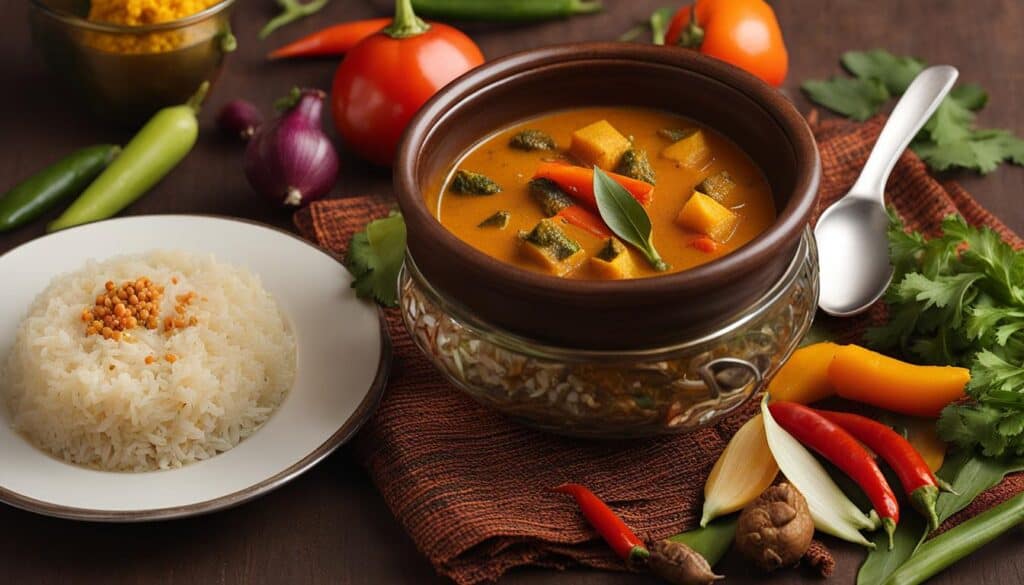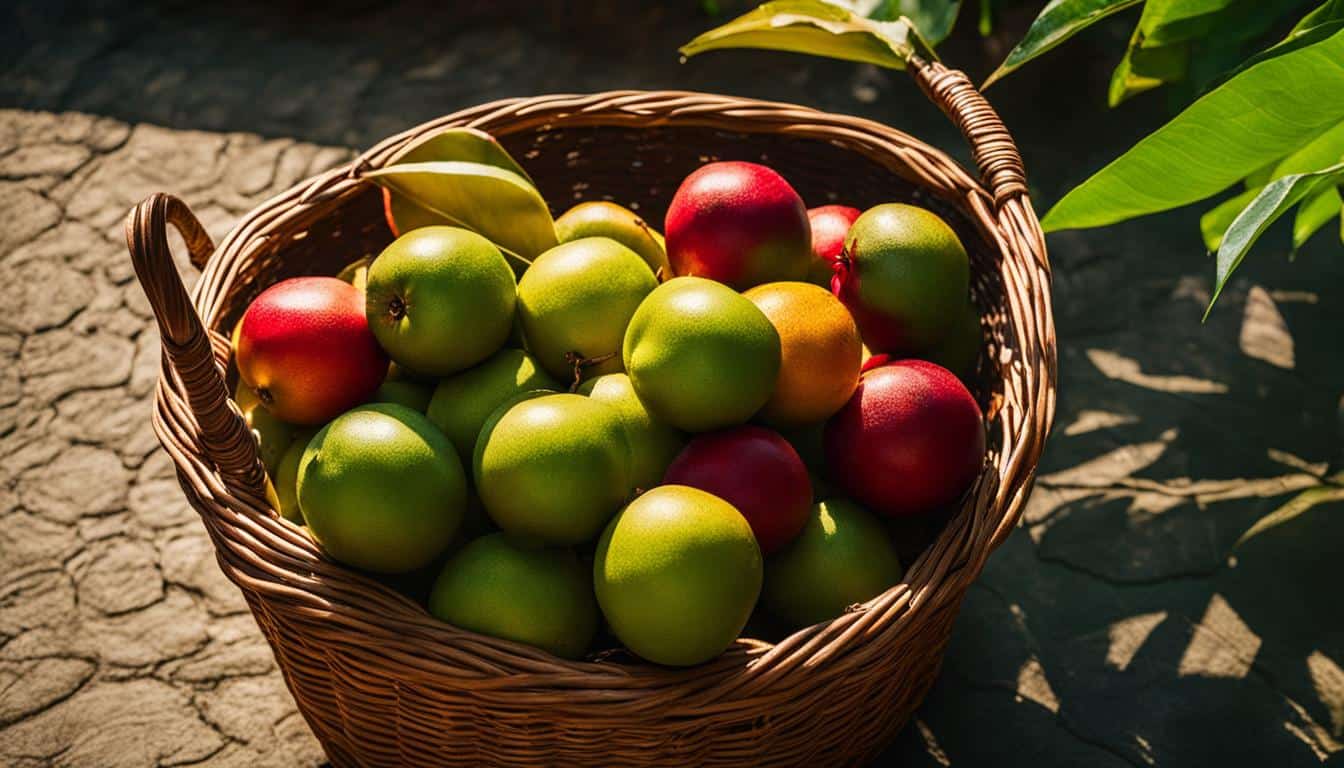Welcome to our latest article where we unveil the hidden gem of South Indian cuisine – Kudampuli! Also known as Garcinia cambogia or Malabar tamarind, this tropical fruit is dried and used as a spice to enhance the flavor of dishes. But Kudampuli is not just any ordinary spice, it offers a plethora of health benefits and can be a valuable addition to your kitchen pantry. Let’s dive in and explore the wonderful world of Kudampuli!
Key Takeaways:
- Kudampuli is a tropical fruit commonly used in South Indian cuisine.
- It is dried and used as a spice to enhance the flavor of various dishes.
- Kudampuli offers several health benefits, including anti-inflammatory properties and aiding in weight loss.
- It is a key ingredient in many traditional South Indian dishes, especially fish curry.
- Kudampuli can be used in a variety of recipes to add a tangy and sour taste.
What is Kudampuli and How is it Prepared?
Kudampuli, also known as Garcinia cambogia or Malabar tamarind, is a tropical fruit that grows on Garcinia cambogia trees in tropical countries. When ripe, the fruit is harvested and sun-dried to reach its black and leathery form. In South Indian cuisine, kudampuli is used as a dried spice similar to other Indian spices, adding a tangy and sour taste to dishes like fish curry and tamarind chutney.
The process of harvesting and drying kudampuli requires care and craftsmanship, making it a unique ingredient in culinary preparations. The fruit is carefully picked when ripe and then left to dry in the sun until it reaches its desired texture. This ensures that the fruit retains its flavor and enhances the taste of the dishes it is added to.
Being a key ingredient in many traditional South Indian dishes, kudampuli is prepared by adding it to curries, stews, and even pickles. Its distinctive tangy flavor works well with both vegetarian and non-vegetarian preparations, making it a versatile ingredient that can elevate the taste of a wide range of dishes.
To summarize, kudampuli is a tropical fruit that is dried and used as a spice in South Indian cuisine. It adds a tangy and sour taste to dishes and is prepared by sun-drying the ripe fruit. With its unique flavor profile and versatility, kudampuli is an essential ingredient that can enhance the taste of various culinary creations.
| Key Information | Kudampuli |
|---|---|
| Nickname | Garcinia cambogia, Malabar tamarind |
| Origin | Tropical countries |
| Preparation | Harvested when ripe and sun-dried |
| Flavor | Tangy and sour |
| Uses | Spice in South Indian cuisine |
Health Benefits of Kudampuli
Kudampuli, also known as Garcinia cambogia or Malabar tamarind, offers several health benefits that make it a valuable addition to your diet. This tropical fruit possesses potent anti-inflammatory properties, making it effective in reducing inflammation and protecting the stomach. Additionally, kudampuli promotes gut health, making it beneficial for individuals with inflammatory bowel diseases. Its fat-burning properties also contribute to weight loss.
Studies have shown that the active ingredient in kudampuli, called hydroxycitric acid (HCA), inhibits an enzyme called citrate lyase, which plays a role in converting excess carbohydrates into fat. By blocking this enzyme, kudampuli may aid in weight loss by reducing the production of fatty acids in the body and suppressing appetite.
Incorporating kudampuli into your diet is easy. It can be added to various dishes, such as fish curry or tamarind chutney, to enhance the flavor and reap its health benefits. You can also soak the dried fruit in water and consume the concoction before meals to promote weight loss.
Summary:
- Kudampuli has potent anti-inflammatory properties and can protect the stomach.
- It promotes gut health and is beneficial for individuals with inflammatory bowel diseases.
- Kudampuli’s fat-burning properties may aid in weight loss by inhibiting the production of fatty acids and suppressing appetite.
- Incorporate kudampuli into your diet by adding it to various dishes or consuming it as a liquid before meals.
Table: Health Benefits of Kudampuli
| Health Benefit | Description |
|---|---|
| Anti-inflammatory properties | Kudampuli can help reduce inflammation and protect the stomach. |
| Gut health promotion | It promotes a healthy gut and can benefit individuals with inflammatory bowel diseases. |
| Weight loss aid | Kudampuli’s fat-burning properties may aid in weight loss by inhibiting fatty acid production and suppressing appetite. |
Kudampuli in South Indian Cuisine
Kudampuli, also known as Malabar tamarind, plays a crucial role in South Indian cuisine by adding a tangy and sour flavor to various dishes. This versatile ingredient is commonly used in traditional South Indian curries, elevating the taste and creating a unique culinary experience.
South Indian cuisine is renowned for its diverse and flavorful dishes, and kudampuli is a key component in many of these recipes. It is especially popular in fish curry, where its tanginess enhances the flavors of the fish and spices. Kudampuli can also be found in tamarind chutney, providing a delightful sour note.

Apart from fish curry and chutney, kudampuli can be used in various other South Indian recipes. It pairs well with a wide range of ingredients, including vegetables, lentils, and meats, adding a unique tanginess to the dishes. Whether you’re preparing sambar, rasam, or avial, incorporating kudampuli can elevate the flavors and create a memorable dining experience.
The distinct taste of kudampuli sets it apart from other souring agents commonly used in Indian cuisine. While tamarind and kokum offer their own unique flavors, kudampuli brings a tanginess that is characteristic of South Indian curries. Its ability to add a refreshing sour element to dishes makes it a beloved ingredient in South Indian cooking.
Kudampuli in South Indian Cuisine
| Dish | Use of Kudampuli |
|---|---|
| Fish Curry | Enhances the flavors and adds a tangy element to the curry. |
| Tamarind Chutney | Provides a delightful sour note to the chutney. |
| Sambar | Elevates the taste and creates a tangy flavor profile. |
| Rasam | Gives a refreshing sourness to the soup. |
| Avial | Adds a tangy twist to the mixed vegetable dish. |
Whether you’re a fan of South Indian cuisine or looking to explore new flavors, kudampuli is a valuable ingredient to have in your kitchen. Its tangy and sour taste can transform ordinary dishes into extraordinary culinary creations. So, why not try incorporating kudampuli into your next South Indian cooking adventure?
Cooking with Kudampuli
When it comes to cooking with kudampuli, the possibilities are endless. This tangy and sour fruit adds a unique flavor profile to dishes, making it a favorite ingredient in South Indian cuisine. One popular dish where kudampuli shines is Kerala fish curry.
Known for its rich and robust flavors, Kerala fish curry is a staple in South Indian households. The addition of kudampuli takes this dish to another level, adding a tangy and refreshing twist. The sourness of kudampuli complements the freshness of the seafood, creating a harmonious blend of flavors that tantalize the taste buds.
To make Kerala fish curry with kudampuli, marinate fish chunks in a flavorful sauce made with kudampuli and aromatic spices. Cooked in a clay pot, this traditional recipe brings out the authentic flavors of the dish, making it a true delight for seafood lovers.
So, whether you’re a fan of seafood or want to explore the unique flavors of South Indian cuisine, incorporating kudampuli into your cooking is a must. Its tangy and sour taste will surely elevate your dishes and leave you craving for more.
| Benefits of Cooking with Kudampuli |
|---|
| Enhances the flavor of dishes |
| Pairs well with seafood |
| Adds a tangy and sour taste |
| Brings a unique flavor profile |
Kudampuli for Weight Loss
Kudampuli, also known as Garcinia cambogia or Malabar tamarind, has gained popularity as a natural ingredient for weight loss. It is believed to have fat-burning properties that can aid in achieving weight loss goals. However, it is important to note that kudampuli should be incorporated into a balanced diet and combined with regular exercise for maximum effectiveness.
To harness the weight loss benefits of kudampuli, one common method is to soak the dried fruit in water and consume the concoction before meals. This is believed to help reduce appetite and control food cravings, contributing to a calorie deficit that can lead to weight loss.
While kudampuli shows promise in supporting weight loss efforts, it is crucial to consult with a healthcare professional before making any significant changes to your weight loss routine. They can provide personalized guidance and ensure that kudampuli is safe for you to consume, especially if you have any underlying health conditions or are taking medication.

Remember, incorporating kudampuli into your weight loss journey is just one piece of the puzzle. It should be combined with a balanced and nutritious diet, regular physical activity, and overall healthy lifestyle habits to achieve sustainable weight loss results.
Kudampuli vs. Other Souring Agents
Kudampuli, also known as Malabar tamarind, is often compared to other souring agents like tamarind and kokum. While they all belong to the same family, they have distinct flavors and are used in different regional cuisines. Tamarind is widely used in Indian cooking, especially in savory dishes, while kudampuli is commonly used in South Indian cuisine. Kokum is popular in Marathi and Konkani cuisine. Each souring agent has its own unique taste and culinary applications.
When it comes to flavor, kudampuli offers a tanginess that is slightly more subtle compared to tamarind. It adds a gentle sourness that enhances the overall taste of dishes without overpowering other flavors. Tamarind, on the other hand, has a more pronounced tartness, which can be especially prominent in certain recipes.
The choice between kudampuli and tamarind depends on personal preference and the specific dish being prepared. Kudampuli is often preferred in South Indian curries and seafood dishes, where its delicate tangy flavor complements the other ingredients perfectly. Tamarind, with its bolder taste, is commonly used in chutneys, stews, and various other Indian dishes where a stronger sour element is desired.
| Souring Agent | Flavor | Cuisine |
|---|---|---|
| Kudampuli | Tangy and subtle | South Indian |
| Tamarind | Tart and pronounced | Various Indian |
| Kokum | Tangy and fruity | Marathi and Konkani |
While kudampuli, tamarind, and kokum all offer their unique flavors, it’s important to select the souring agent that best complements the dish you are preparing. Experimenting with different souring agents can open up a world of culinary possibilities and allow you to explore the diverse tastes of various regional cuisines.
Potential Side Effects of Kudampuli
Kudampuli, despite its numerous health benefits, may have potential side effects that should be taken into consideration. It is crucial to be aware of these side effects, especially if you have diabetes or any underlying health conditions. The sourness of kudampuli can impact blood sugar levels, so monitoring your blood sugar levels is essential when consuming this tropical fruit.
It is recommended to use kudampuli in moderation as part of your regular cooking routine. While it adds a tangy flavor to dishes, excessive consumption may lead to adverse reactions. If you experience any discomfort or unusual symptoms after consuming kudampuli, it is advisable to consult with a healthcare professional for further guidance.
Kudampuli offers incredible health benefits, but it is important to remember that moderation is key. By using it in appropriate amounts and being mindful of any potential side effects, you can enjoy the unique flavors of kudampuli while taking care of your well-being.
Table: Potential Side Effects of Kudampuli
| Side Effects | Precautions |
|---|---|
| Affects blood sugar levels | Monitor blood sugar levels, especially if you have diabetes or other health conditions |
| Possible gastrointestinal discomfort | Consume kudampuli in moderation and discontinue use if any adverse reactions occur |
| Allergic reactions | Consult a healthcare professional if you experience any allergic symptoms |
Remember, kudampuli is a natural ingredient that can provide many benefits, but it is essential to listen to your body and make informed decisions regarding its consumption. By practicing moderation and seeking professional advice when needed, you can experience the advantages of kudampuli while minimizing any potential side effects.

Using Kudampuli in Sambar
Kudampuli, with its distinct tangy flavor, is a delightful addition to traditional Indian dishes like sambar. This tropical fruit adds a unique element to the dish, enhancing its taste and creating a memorable dining experience.
Incorporating kudampuli into sambar not only elevates the flavors but also provides potential health benefits. Kudampuli is known for its anti-inflammatory properties and its contribution to gut health. By including this tangy ingredient in your sambar recipe, you can add a nutritious twist to an already delicious dish.
“Kudampuli adds a tangy and refreshing flavor to sambar, complementing the blend of aromatic spices and vegetables. It gives the dish a unique taste that is loved by many. Don’t miss the opportunity to try this exciting variation!”
To use kudampuli in sambar, simply soak the dried fruit in warm water for about 15-20 minutes until it softens. Then, squeeze out the pulp and discard the seeds. Add the extracted pulp to your sambar along with the other ingredients, and let it simmer to allow the flavors to meld together.
Discover the tangy goodness of kudampuli in sambar, and take your taste buds on a flavorful journey through South Indian cuisine!

Benefits of Using Kudampuli in Sambar
When using kudampuli in sambar, you not only add a tangy and refreshing flavor, but you also reap the potential health benefits it offers. Kudampuli contains anti-inflammatory properties that can help reduce inflammation in the body. Moreover, it contributes to gut health, making it a valuable addition to your diet. So, by incorporating kudampuli in sambar, you can enjoy a flavorful meal while taking care of your well-being.
Where to Buy Kudampuli
If you’re looking to buy kudampuli, there are various options available to you. Whether you prefer kudampuli extract, capsules, or the dried fruit itself, reputable suppliers can provide you with authentic kudampuli products.
When purchasing kudampuli extract, it’s important to choose a trusted supplier who specializes in providing high-quality and pure extracts. Look for suppliers who source their kudampuli from reliable and sustainable farms to ensure the authenticity of the product.
In addition to extracts, kudampuli capsules are also a convenient option. These capsules contain the beneficial properties of kudampuli in a concentrated form, making it easy to incorporate into your daily routine. Again, make sure to choose reputable suppliers who prioritize quality and transparency.
Table: Comparison of Kudampuli Products
| Kudampuli Product | Benefits | Supplier |
|---|---|---|
| Kudampuli Extract | Highly concentrated form, easy to incorporate into recipes | Reputable suppliers specializing in herbal extracts |
| Kudampuli Capsules | Convenient and portable, suitable for on-the-go consumption | Trusted suppliers of natural health supplements |
| Dried Kudampuli Fruit | Traditional form, adds a tangy flavor to various dishes | Reputable suppliers offering authentic and sun-dried kudampuli |
When purchasing kudampuli, prioritize suppliers who value sustainability, ethical practices, and product integrity. Research customer reviews and recommendations to ensure that you’re choosing a supplier with a good reputation.
By selecting trusted suppliers, you can enjoy the benefits of kudampuli and incorporate this unique ingredient into your culinary creations with confidence.
Cooking Kerala-style Fish Curry with Kudampuli
When it comes to traditional Kerala cuisine, one dish that stands out is the Kerala-style fish curry with kudampuli. This delectable dish combines the freshness of fish with the tangy flavors of kudampuli, resulting in a delightful culinary experience. To prepare this authentic recipe, start by marinating chunks of fish in a flavorful sauce made with kudampuli and aromatic spices.
The secret to a truly authentic Kerala-style fish curry lies in the clay pot used for cooking. The clay pot enhances the flavors and adds a distinct earthiness to the dish. As the fish cooks, it absorbs the tangy and spicy flavors of the kudampuli sauce, creating a harmonious blend of taste and texture. The result is a rich and flavorful curry that pairs perfectly with steamed rice or appam.
To create a truly memorable Kerala-style fish curry, it’s important to use fresh ingredients and follow the traditional cooking method. The combination of fragrant spices, tangy kudampuli, and succulent fish chunks will transport you to the coastal regions of Kerala. Whether you are a fan of South Indian cuisine or simply looking to explore new flavors, this traditional recipe is a must-try.

Ingredient List:
- Fish (choose any firm-fleshed fish like Kingfish or Sardines) – 500 grams
- Kudampuli (dried Garcinia cambogia) – 2 to 3 pieces
- Coconut oil – 2 tablespoons
- Mustard seeds – 1 teaspoon
- Fenugreek seeds – 1/2 teaspoon
- Curry leaves – a handful
- Onion (sliced) – 1 large
- Tomato (chopped) – 1 medium
- Green chili (slit) – 2 to 3
- Ginger-garlic paste – 1 tablespoon
- Red chili powder – 1 teaspoon
- Turmeric powder – 1/2 teaspoon
- Coriander powder – 2 teaspoons
- Salt – to taste
- Water – as required
- Fresh coriander leaves (chopped) – for garnishing
Instructions:
- Soak the kudampuli in warm water for about 15 minutes until it softens.
- Heat coconut oil in a clay pot or a deep pan.
- Add mustard seeds and fenugreek seeds. Once they splutter, add curry leaves and sauté for a few seconds.
- Next, add sliced onion and sauté until golden brown.
- Add ginger-garlic paste and sauté until the raw smell disappears.
- Add chopped tomato and cook until it turns mushy.
- Now, add red chili powder, turmeric powder, coriander powder, and salt. Mix well.
- Add the soaked kudampuli along with the water it was soaked in. Stir well.
- Add water as required to achieve the desired consistency of the curry.
- Bring the curry to a boil and then add the fish chunks. Cook until the fish is done and the curry thickens.
- Garnish with freshly chopped coriander leaves.
- Serve hot with steamed rice or appam.
Enjoy the burst of flavors and the unique tanginess of the Kerala-style fish curry with kudampuli. This traditional recipe is sure to impress your taste buds and transport you to the beautiful coastal regions of Kerala.
Conclusion
Kudampuli, also known as Garcinia cambogia or Malabar tamarind, is a versatile tropical fruit that can revolutionize your culinary experience. With its tangy and sour flavor, kudampuli adds a unique twist to traditional South Indian dishes like fish curry and sambar. Beyond its culinary applications, this magical fruit offers several health benefits.
Kudampuli has powerful anti-inflammatory properties that can protect against inflammation and promote gut health. Its fat-burning properties make it a popular natural ingredient for weight loss. However, it is important to use kudampuli in moderation and consult with a healthcare professional if you have any underlying health conditions.
Whether you’re a fan of South Indian cuisine or looking to explore new flavors, kudampuli is a must-have ingredient in your kitchen. You can find authentic kudampuli products, including extracts and capsules, from trusted suppliers. So, why wait? Upgrade your meals and embrace the tangy goodness of kudampuli today!
FAQ
What is kudampuli and how is it prepared?
Kudampuli, also known as Garcinia cambogia or Malabar tamarind, is a tropical fruit commonly used in South Indian cuisine. It is dried and used as a spice to enhance the flavor of various dishes.
What are the health benefits of kudampuli?
Kudampuli contains potent anti-inflammatory properties that can help reduce inflammation and protect the stomach. It is also known to improve gut health and may aid in weight loss.
How is kudampuli used in South Indian cuisine?
Kudampuli is a key ingredient in many traditional South Indian dishes, particularly fish curry and tamarind chutney. It adds a tangy flavor to the dishes.
How can I cook with kudampuli?
Kudampuli can be used in a variety of recipes to add a tangy and sour taste. It pairs well with seafood, especially in dishes like Kerala fish curry. It can also be added to vegetarian dishes for a burst of tanginess.
Can kudampuli help with weight loss?
Kudampuli is often used as a natural ingredient for weight loss due to its fat-burning properties. However, it is important to incorporate kudampuli into a balanced diet and consult with a healthcare professional before making any significant changes to your weight loss routine.
How does kudampuli compare to other souring agents?
Kudampuli, tamarind, and kokum are all souring agents used in different regional cuisines. Kudampuli is commonly used in South Indian dishes, while tamarind is widely used in Indian cooking. Each souring agent has its own unique taste and culinary applications.
Are there any potential side effects of kudampuli?
The sourness of kudampuli can affect blood sugar levels, so it is important to monitor blood sugar levels if you have diabetes or any other underlying health conditions. It is also recommended to use kudampuli in moderation as part of your regular cooking routine.
How can I use kudampuli in sambar?
Kudampuli can add a tangy flavor to traditional Indian dishes like sambar. It enhances the taste and adds a unique element to the dish.
Where can I buy kudampuli?
Kudampuli is widely available in various forms, including extracts and capsules. It can be sourced from reputable suppliers who specialize in providing authentic kudampuli products.
How can I cook Kerala-style fish curry with kudampuli?
Kerala-style fish curry with kudampuli is a popular dish that showcases the unique flavors of kudampuli. It is prepared by marinating fish chunks in a tangy and flavorful sauce made with kudampuli and aromatic spices. This traditional recipe is often cooked in a clay pot, which enhances the flavors and brings out the authenticity of the dish.





Leave a Reply